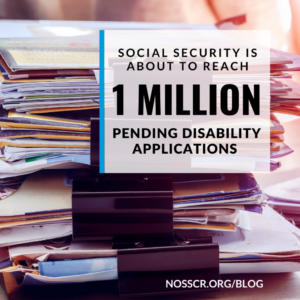We’re Fast Approaching One Million People Awaiting Decisions
We are heading towards a dismal threshold; at the state agencies the Social Security Administration (SSA) contracts with for initial-level medical determinations and the first level of appeals (called reconsideration), there will soon be over a million cases awaiting decisions.
At the end of December 2021, there were 971,426 pending cases: 776,660 initial claims and 194,766 reconsiderations, according to SSA data (which is broken down by state and territory). This is a 9.4% increase over December 2020 and 27.6% higher than the number of claims pending in December 2019.
There are many reasons for this increase, but a high number of applications is not among them. In fact, disability claims have been decreasing for over a decade, and the decline has steepened during the pandemic. According to SSA data, fewer Social Security Disability Insurance (SSDI) disabled worker claims were filed in 2021 than in any year since at least 2006. Data on Supplemental Security Income (SSI) claims show a 17% decrease in child SSI applications and a 13% decrease in applications for people aged 18-64 from 2019 to 2020 (the most recent information available).
The National Association of Disability Examiners (NADE) reported that the national average processing time last year was 165 days for initial claims and 147 days for reconsiderations. In Fiscal Years 2015-2019, the average processing time ranged from 110-120 days for initial claims and 101-113 days for reconsiderations.
More people waiting for disability decisions, and longer waits for the decisions, are taking a toll on individuals, families, and communities. In some situations, eligibility for SSI or SSDI allows an uninsured person to obtain Medicaid or Medicare, so delays in processing disability claims can cause people to delay medical treatment, or leave hospitals and clinics to provide more uncompensated care.
Additional administrative funds for SSA could improve the situation. The House passed an appropriations package that would increase funding, but it hasn’t become law; the federal government is operating on a continuing resolution that freezes SSA’s funding at last year’s level. SSA could also resume the policy it had during the first months of the pandemic when state agencies were directed to focus on initial and reconsideration decisions instead of Continuing Disability Reviews (CDRs), which determine if current beneficiaries have medically improved and no longer qualify for disability benefits.
While there are a number of ways to change course, it requires action. We hope to be able to share a swift resolution soon.
Share!
Follow us
Recent posts
Point of view: One way for SSA to secure promised benefits
As our members know all too well, Social Security is a vital social safety net, the importance of which cannot be overstated. Yet solvency of the Social Security trust fund remains a looming issue. At...
National Organization of Social Security Claimants’ Representatives Appoints David Camp as Permanent CEO
WASHINGTON, D.C., January 23, 2024 — The National Organization of Social Security Claimants’ Representatives (NOSSCR) today announced that David Camp has been hired as Chief Executive Officer. Camp has been serving as the organization’s interim...
Disability recipients nearly 7 times more likely to die of COVID-19, according to SSA data
The Social Security Administration has released data showing a shocking disparity: Current and former disability recipients – just 4% of the U.S. population – made up 26% of excess deaths during the first 22 months...



